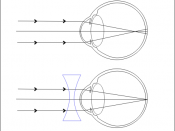Marketing myopia: Theodore � PAGE \* MERGEFORMAT �5�
Running head: MARKETING MYOPIA: THEODORE LEVITT
Marketing Myopia: Theodore Levitt
University of Phoenix
�
Marketing Myopia
In Theodore Levitt's article, "Marketing Myopia" (1975), the concept of marketing was widened by examining the history of failed industries doomed to fail eventually. Industries failed to continue their growth not because of a saturated market but failure of proper management. They did not realize the need of expanding into areas in which they were already familiar. Levitt used the railroads as an example because railroads were not focusing on other modes of transportation such as cars and planes, and ships. The railroads only wanted to think of rail transport. Levitt also used other examples such as Hollywood not defining itself correctly, thinking they were a movie business instead of an entertainment business. When TV came out, it almost destroyed Hollywood because of their myopic marketing.
The major problem with these industries was the issue of product orientation rather than customer-oriented. To survive, their products and services had to be marketed differently according to the customers' needs. According to Levitt's research, companies go out of business because they take the customer and market for granted. Businesses must not remain stagnate but must constantly change as the market and its needs change if they want to stay in business.
Levitt argues his first point-of-view on the shadow of obsolescence and that "there is no such thing as a growth industry," but growth opportunities. Levitt termed the stagnation of growth industry as a self-deceiving cycle. Within this cycle, there are warning signs that tell if an industry will fail. The first sign is the population myth; the belief that a rise in population "growth is assured by an expanding and more affluent population" does not necessarily...


